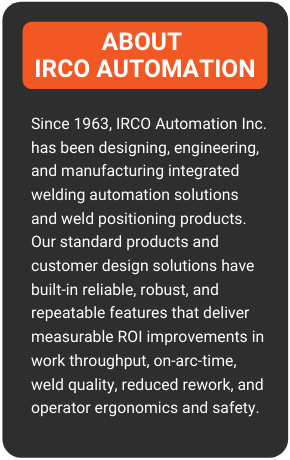
Read further to learn about ways to help reduce the risks associated with welding automation. We break it down into two sections or "rules" :
.png?width=600&name=Author%20Headers%20(7).png) One of the benefits of automating a welding process is that it helps to reduce many safety hazards. For example, the use of pre-programmed part positioning, welding motions, and integrated safety devices means there is less exposure and less need for operators to be in the "work zone". Also, using weld positioners leads to less material handling, meaning there are fewer part pick-ups or manual part rotations during the welding process, thereby generally improving overall operator safety.
One of the benefits of automating a welding process is that it helps to reduce many safety hazards. For example, the use of pre-programmed part positioning, welding motions, and integrated safety devices means there is less exposure and less need for operators to be in the "work zone". Also, using weld positioners leads to less material handling, meaning there are fewer part pick-ups or manual part rotations during the welding process, thereby generally improving overall operator safety.
[More about the benefits of welding automation here]
But, let's be clear for a moment - automation can be dangerous and there still are risks, especially if automating the process hasn't been carefully planned out. If you look at the health and safety hazards associated with a robotic arm, for example, human error, control errors, or disruptions in its power system can lead all carry risks. Or, consider how quickly how servo motors on their own work - moves are completed according to a program, not a joystick or button, and the servo is always looking for its next signal. So, a programming glitch (servo failure) could potentially cause the robotic arm could to swing its full radius, striking anything in its path.
With just this one simple example, it's evident that safety in an automated system isn't something that should ever be overlooked. We believe in helping to make a company's process as safe as possible and welding automation can help do that when key steps are taken.
Read further to learn about ways to help reduce the risks associated with welding automation. We break it down into two sections or "rules" :
RULE 1: SAFETY BUILT INTO THE DESIGN
.png?width=600&name=Copy%20of%20Safety%20should%20be%20a%20first%20thought%2c%20Not%20an%20afterthought.%20This%20is%20true%20in%20the%20process%20of%20designing%20any%20automated%20welding%20system.%20(2).png)
Designing with safety as a priority:
Safety should be a first thought, not an afterthought - this true is in the process of designing any automated welding system.
Safety should always be a priority conversation point with a client, and it should always be a two-way conversation.
Four critical things that should be discussed include:
- Reviewing the existing risks and hazards in the customer's existing (welding or material handling)
- Clarifying which of those existing safety hazards the automated system will improve
- Assessing identify what could potentially cause harm or create risk in the proposed design
- Identifying the safeguards built into the design that will help reduce the identified risks or eliminate them
.png?width=632&name=Welding%20automation%20training%20is%20important%20(2).png)
Examples of safety features available for welding automation:
Depending on the purpose and components of the automated system, safety features may include things such as:
- Guarding, light curtains and shrouding around the torch or system to provide protection from the arc flash
- Guarding and fencing around areas of the system that are "higher-risk-areas" that only an operator should be in or areas that no one should be in while the system is working
- Pressure-sensitive operator mats and sensors to recognize and automatically stop the system if the operator isn't in the correct place
- Scanners, sensors and automatic emergency stops so that the system recognizes when someone or something has entered the work zone.
RULE 2: TRAINING AS AN INVESTMENT
.png?width=800&name=Copy%20of%20Safety%20should%20be%20a%20first%20thought%2c%20Not%20an%20afterthought.%20This%20is%20true%20in%20the%20process%20of%20designing%20any%20automated%20welding%20system.%20(1).png)
Our team believes that training is an investment, not an expense.
Accidents can quickly happen during testing, maintenance, and other routine procedures, making it important that anyone interacting with the system, including managers, operators, welders, maintenance technicians, etc. receives training.
Improper use or repair of an automated system can compromise the integrity of the safety features, create new hazards, and reduce the benefits your system was designed to help achieve. The higher the level of training your team has helps to both create a path to being safer and eliminate hazards in the workplace.
It is very common for customers to begin their initial training with their new system at our facility and then continue with dedicated in-person training at their own location after our team has completed the install. These commissioning training days provide your manufacturing team with the opportunity to learn and begin using the system with help and supervision.
IN CONCLUSION...
Welding automation is an important investment for improving the safety of your manufacturing process. Whomever you choose to have design, build, and install your system, they should be able to outline the built-in safety features for you and make safety a priority in the design journey. Taking all the available opportunities for training your team (beyond just the operators) will help ensure that the system is used safely and according to its intended purpose.
Ready to get started? Or have specific questions?
Connect with our team about your project by either:
- Filling out this form and providing a few details
- Or, booking a phone/video call with one of our welding automation specialists at a time that is most convenient for your schedule
Looking to learn more?
For more information about welding automation, check out the following resources:
- What are the benefits of Welding Automation?
- Welding Automation - Turn-key Solutions
- IRCO Delivers Linear Robot for Box Beam welding
- What are the different types of welding automation available?
- 4 Reasons to keep your Spare Parts List Up to date

.png)
.png?width=2140&name=Untitled%20design%20(61).png)

